Hey there, fellow DIY enthusiasts! I’m excited to share my love for woodworking with you. I’ve tried many classes and workshops. There’s nothing like making something beautiful with your own hands.
Woodworking classes teach you many skills, from basic to advanced. You can learn about furniture making and wood carving. You’ll use top-notch tools and materials.
Local stores like Woodcraft have classes for all skill levels. These classes teach you more than just techniques. You’ll learn about safety, planning projects, and best practices. It’s a great way to be creative and learn from experts in a friendly setting.
Key Takeaways
- Hands-on training in a variety of woodworking techniques and projects
- Classes taught by experienced instructors in a supportive environment
- Learn workshop safety, project planning, and best practices
- Explore your creativity and develop new skills
- Classes available for all skill levels, from beginner to advanced
Introduction to Woodworking Classes
Woodworking classes teach you how to work with wood. They start with basics and go to advanced techniques. This is a safe place to start your woodworking journey.
What Are Woodworking Classes?
These classes cover tool use, safety, and project planning. You’ll learn to use machines and hand tools. The classes are hands-on, making learning practical.
Benefits of Taking a Woodworking Class
Woodworking classes help you develop skills and use professional tools. You’ll learn many woodworking skills, from hand tools to furniture-making. You might even work with your own wood, making things like toys and furniture.
“Woodworking classes provide a hands-on learning experience that is invaluable for both beginners and experienced woodworkers. The guidance and support of skilled instructors can help you develop essential skills and tackle ambitious projects with confidence.”
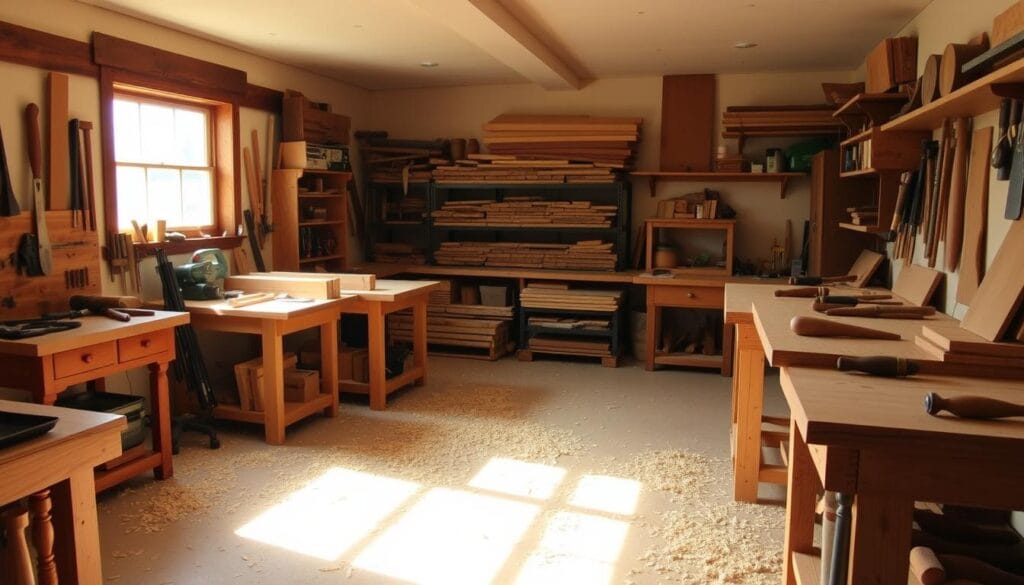
For example, Woodcraft has classes like “Woodworking Fundamentals I.” Beginners learn to use tools to make a cutting board. These classes are the start for more advanced courses, like “Woodturning I” and “Woodturning II.”.
| Specialized Woodworking Courses |
|---|
| A Finer Table, Build a Skateboard, Carving the Tudor Rose, Frames and Panels, Fundamentals of Woodworking, Hand Tools, Hand-Cut Dovetails, Marquetry, Pen In One Day, Spoon Carving By Hand, Take Home Jigs, The Bandsaw Box, Traditional Dovetails, Wood + Metal, Wood Tool Sharpening, Wooden Bench, Wooden Box, Wooden Toy |
Some classes need you to take others first. For example, “Woodworking I” is needed for “A Finer Table” and “Frames and Panels.” Woodworking classes give you a solid foundation and help you build projects with confidence.
Types of Woodworking Classes Available
Woodworking classes are for everyone, from beginners to experts. They help you learn basic skills or improve advanced ones. You can explore your creativity in woodshop training and furniture making workshops.
Beginner Classes
Beginner classes, like “Woodworking Fundamentals I,” start with the basics. They teach you how to use tools safely and choose the right wood. There are 16 beginner classes covering topics from safety to furniture making.
Intermediate and Advanced Classes
Intermediate and advanced classes get into more complex skills. “Woodworking Fundamentals II” teaches advanced joinery and design. These classes are longer, letting you work on detailed projects.
Woodworking Masterclasses offers free and paid tutorials for all levels. Topics include making workshops, furniture, and understanding wood types.
Specialty Classes
Specialty classes focus on specific interests, like “Knife Making 101” or “Build a Windsor Stool.” They teach traditional techniques and help you make unique pieces.
The article lists many woodworking class options. You can find classes at art centers, maker spaces, and online. Platforms like Craftsy and Udemy offer a wide range of courses.

Whether you’re new or experienced, there’s a woodworking class for you. Classes range from basics to specialized techniques. They provide the tools and knowledge to grow your woodworking skills.
What to Expect in Woodworking Classes
Woodworking classes offer a mix of learning and doing. You’ll see demonstrations and get to try things out yourself. Classes like “Woodworking Fundamentals I” at Cabinetry Courses last a full day. This gives you plenty of time to learn and practice.
Course Structure and Learning Methods
Classes usually have lectures, demos, and group projects. You’ll learn about using tools safely, designing projects, and choosing lumber. You’ll also work on your own projects. The schedule can change, depending on the course length. You’ll know the start and end times, and when to take breaks.
Tools and Materials Used
You’ll get to use top-notch tools like table saws and routers. The materials vary, from hardwoods for cutting boards to special kits for making knives. You’ll work with different woods and designs to improve your skills.
Safety Protocols in Woodworking
Safety is key in woodworking classes. Each class starts with safety lessons. You’ll learn how to use tools correctly. Instructors stress the need for safety gear and proper practices. They help you become a skilled and safe woodworker.
Woodworking classes are great for beginners and experts alike. They offer a mix of theory and practice. You’ll become more confident and skilled in creating wood projects.

Finding Woodworking Classes Near You
Discover the joy of woodworking by exploring local classes. Whether you’re new or experienced, there’s plenty to learn and improve.
Online Search Tips
Begin by searching online for woodworking classes. Use terms like “wood turning lessons” and “joinery tutorials” to find nearby classes. Websites like Woodcraft’s store locator can help you find workshops and lessons.
Community Colleges and Adult Education Programs
Community colleges and adult education programs have many woodworking classes. They offer a structured learning space and a chance to meet others who love woodworking.
Local Woodworking Shops and Studios
Visit local woodworking shops and studios for classes and workshops. Woodcraft stores in the US offer various hands-on lessons, from wood turning lessons to joinery tutorials. These classes let you learn from experts and get hands-on experience in a great workshop.
Also, check out specialized schools like the Hudson River Maritime Museum. They have many woodworking courses for different interests.
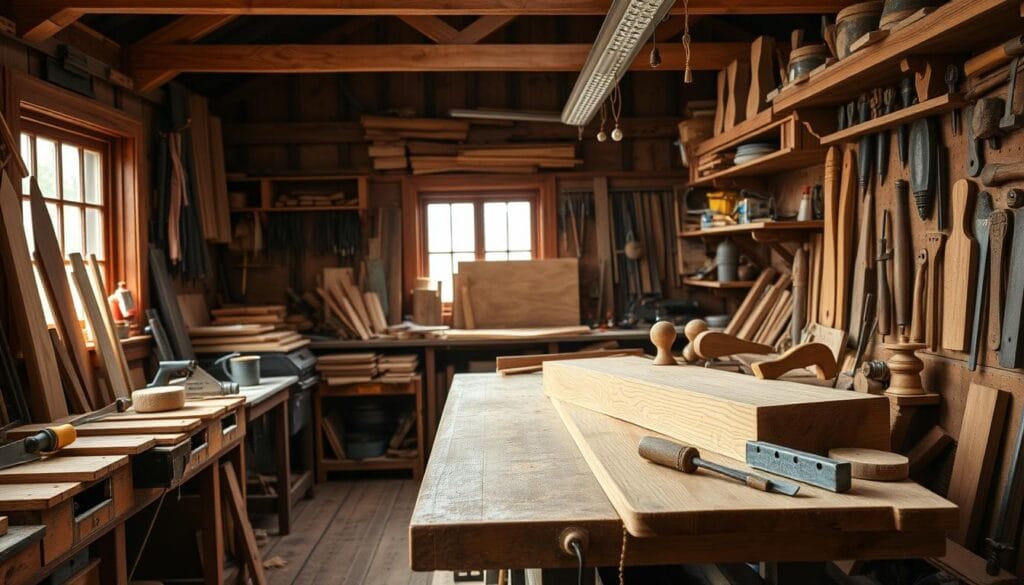
“Woodworking is a lifelong journey of learning and creating. The classes you take will open up a world of possibilities, allowing you to express your creativity and hone your skills.”
Whether you like online tutorials or hands-on workshops, there are many options for woodworking classes near you. Start your woodworking journey and enjoy creating with your own hands.
Popular Woodworking Techniques Taught in Classes
Woodworking classes are great for both beginners and experienced woodworkers. They teach essential techniques to improve your skills and creativity. You can learn classic joinery, woodturning, and more, from the basics to advanced levels.
Joinery Techniques
Joinery is key to making strong woodworking projects. Classes cover techniques like mortise and tenon, dovetails, and pocket holes. These skills help you make durable furniture and decorative items.
Finishing Methods
Finishing is what makes wood look amazing. Classes teach oil finishing, staining, and varnishing. Learning these techniques helps you protect and enhance your woodcraft.
Woodturning Basics
Woodturning is a favorite topic in many classes. Students learn to make bowls, vases, and ornaments on a lathe. They get hands-on practice with tools and techniques specific to woodturning.
Carving Fundamentals
Wood carving classes teach the basics. Students learn about tools, techniques, and wood types. These classes spark creativity and deepen your appreciation for woodcarving.
Woodworking classes are great for all woodworkers. They help you learn new skills, improve your techniques, and explore your creativity.

“Attending woodworking classes allows students to learn new tool grinds, postures, and techniques from experienced instructors, enhancing the learning experience.”
Woodworking classes cover a wide range of techniques. They show the tradition and growth of this craft. Whether you’re into furniture making, wood carving, or woodturning, these classes can boost your skills and creativity.
Benefits of Taking Woodworking Classes
Woodworking classes open up a world of benefits beyond just improving your carpentry skills. As you start your woodworking journey, you’ll see how these classes can change your life. They help with personal growth and let you express your creativity.
Skill Development
With the help of skilled teachers, you’ll learn a lot more than just how to use tools. Classes like “Woodworking Fundamentals I” teach you about safety and how to finish projects. This gives you a solid base to work on harder projects.
Creative Expression
Woodworking classes are great for letting your creativity shine. You can make everything from custom knife handles to ornaments. This lets you add your own style to each piece. Making something with your own hands can make you feel proud and confident.
Networking Opportunities
Woodworking classes also help you meet new people. Places like Woodcraft host events where you can share ideas and work on projects together. These connections can lead to new hobbies, jobs, or even friends for life.
Woodworking classes can improve your focus, mood, and problem-solving skills. They change you in big ways. Start your woodworking journey and see how it can change your life.
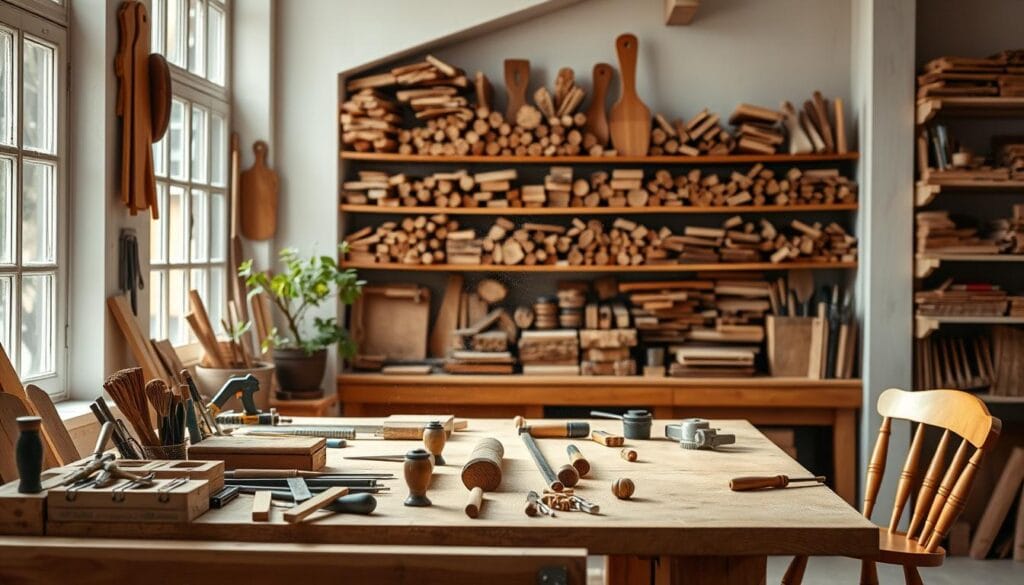
| Benefit | Description |
|---|---|
| Skill Development | Woodworking classes teach proper tool usage, safety protocols, and project completion techniques, providing a strong foundation for more complex projects. |
| Creative Expression | Woodworking classes foster a nurturing environment for creative expression, allowing you to infuse personal style and vision into your projects. |
| Networking Opportunities | Woodworking classes provide opportunities to connect with other enthusiasts, share knowledge, and collaborate on projects. |
“Crafting in class serves as a platform for creative expression, experimentation, and the development of innovative problem-solving skills.”
Factors to Consider When Choosing a Class
When picking a woodworking class, think about a few key things. Class size, instructor skill, and cost are all important. They help make your learning experience better. Let’s dive into these important factors.
Class Size and Instructor Experience
Class size affects how much one-on-one time you get. Smaller classes, with 4 to 8 students, offer more personal attention. This makes learning more hands-on and immersive. Also, an experienced instructor can make a big difference in your learning. Look for classes with seasoned professionals.
Class Duration and Schedule
Woodworking classes vary in length and format. For example, a 3-hour class might be perfect for a quick skill boost. But a 3-day course gives you a deeper dive into woodworking. Think about your schedule and what you want to learn when picking a class.
Cost of Enrollment
Prices for woodworking classes vary a lot. They can range from free to expensive multi-day courses. The cost depends on class length, materials, and instruction level. When choosing, consider your budget and what you’ll get for your money.
By looking at these factors, you can find a woodworking class that fits your needs. Whether you’re new or experienced, there’s a class for you. It can help you grow your skills and enjoy woodworking.
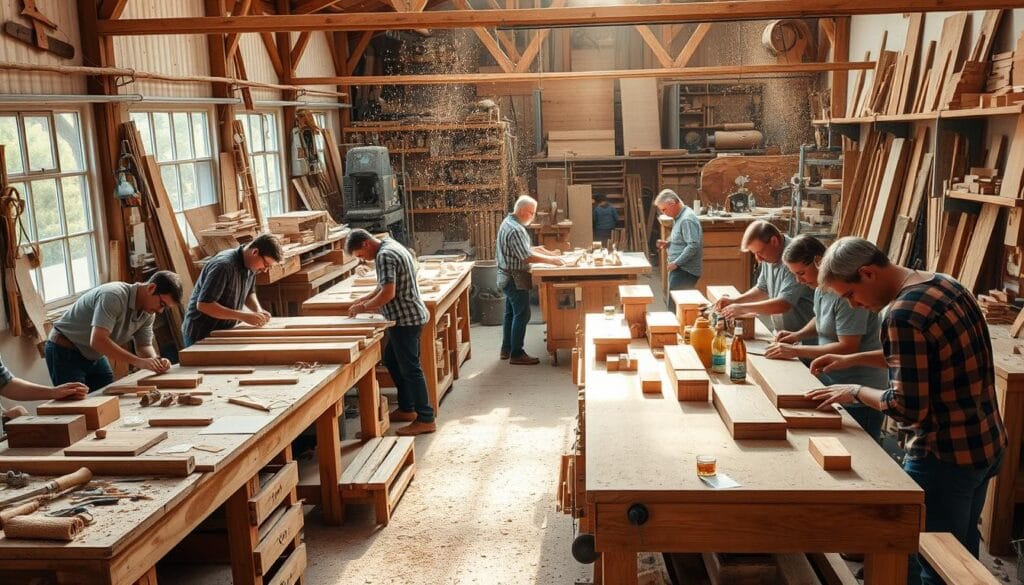
| Class Name | Duration | Cost | Key Focus |
|---|---|---|---|
| Craft a Side Table | Single session | $245 | Introduction to basic woodworking techniques |
| Furniture Restoration | 12 hours | $225 | Assessment and repair of furniture |
| Introduction to Furniture Making | 16 hours | $695 | Foundational woodcraft skills |
| Intermediate Woodworking | 36 hours | $570 | Advanced woodworking projects |
Choosing a woodworking class should match your interests and goals. The right class can teach you new skills, spark creativity, and even lead to job opportunities.
Essential Tools for Woodworking Classes
Woodworking classes, whether for wood carving or wood turning, need specific tools. These tools are crucial for a good learning experience. Knowing the essential tools helps you prepare and enjoy your woodworking education.
Beginner Tools vs. Advanced Tools
Beginner woodworking classes use basic power tools like table saws, jointers, and routers. These tools teach new woodworkers the basics. As you get better, advanced classes introduce special tools like lathes and CNC machines.
Most woodworking classes, like those at Woodcraft, provide all the tools you need. This means beginners can start learning without buying tools first.
Tool Maintenance and Care
Woodworking classes teach how to keep tools in top shape. Students learn to ensure their tools work well and safely. This skill helps them care for their tools long after class, letting them keep woodworking as a hobby.
Recommended Brands
Woodworking classes often use top-quality tools from well-known brands. For example, the “Using the Shaper Origin” class at Woodcraft uses a handheld CNC router from this brand.
Knowing the essential tools for woodworking classes helps you prepare better. It ensures you have the skills and knowledge to make beautiful wood projects. Whether you’re starting or want to improve, these classes offer the foundation and guidance you need.
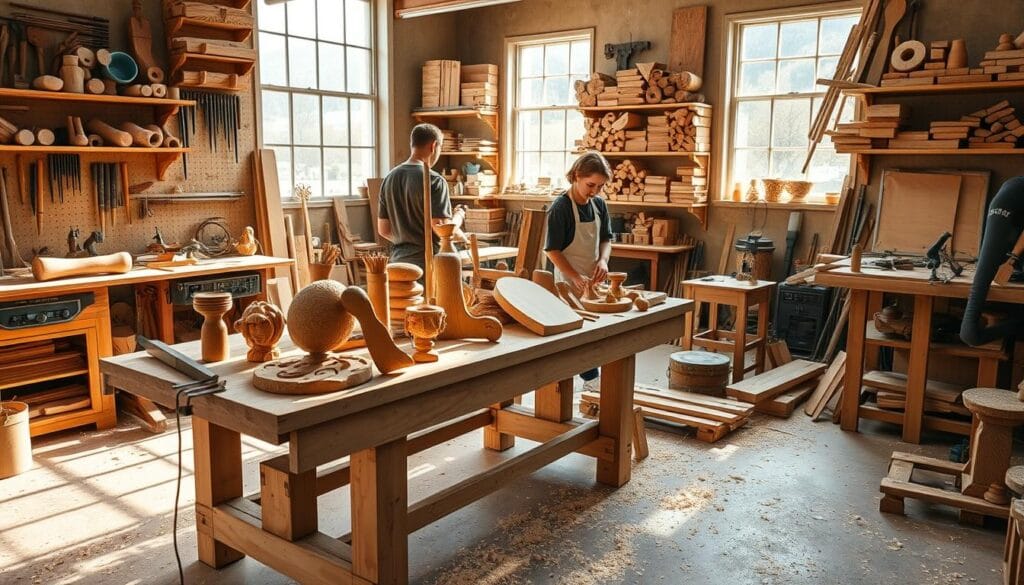
“The right tools in the right hands can transform a simple piece of wood into a remarkable work of art.” – Woodworking Instructor
Learning Outcomes from Woodworking Classes
Woodworking classes offer many benefits. You can learn to complete projects, improve your hand-eye coordination, and understand wood better. These classes are great for everyone, no matter your skill level.
Project Completion
In classes like “Woodworking Fundamentals I,” you get to make things like cutting boards. You learn about choosing wood, using tools, and finishing techniques. The classes run for 12 weeks, from 9:00 am to 5:00 pm, Monday to Friday. This lets you dive deep into woodworking.
Hand-Eye Coordination Improvement
Woodworking classes help improve your hand-eye coordination. You’ll practice with hand planes and power tools. The school has top-quality hand tools for each workbench. This lets you try out different tools before buying.
Understanding Wood Properties
Learning about wood types is key in woodworking. Classes cover wood movement, grain direction, and finishes for different woods. This knowledge helps you choose the right materials and techniques for your projects.
Woodworking classes boost your confidence and prepare you for more complex projects. The school also offers housing for students, making learning more immersive.

“Woodworking classes allow students to become inventors and engineers, promoting a different type of hands-on learning experience compared to traditional classroom settings.”
The woodworking program at The School in Rose Valley has been a core part of the school since its start. It focuses on building self-esteem, mental resilience, and teaching responsibility. These classes offer more than just woodworking skills.
Whether you’re new to woodworking or want to improve, these classes are a great chance to learn. You’ll gain skills in project completion, hand-eye coordination, and understanding wood properties.
The Role of Certification in Woodworking
Getting certified in woodworking isn’t a must for hobbyists. But, it’s a big plus for those who want to make a career out of it. It shows you’ve got a certain level of skill and knowledge. This is great for building your reputation in the industry.
Importance of Certification
Programs like those from the Woodwork Career Alliance of North America (WCA) and the National Wood Flooring Association (NWFA) are recognized. They teach everything from basic to advanced woodworking skills. Having these certifications can prove your skills and might be needed for some jobs or to move up in your career.
Recognized Certification Programs
Even though classes at Woodcraft don’t give official certifications, they still teach valuable skills. These classes can help you get ready for professional certification programs. For example, the Wood Design program at the Sam Beauford Woodworking Institute is a 40-week course. It gives a Professional Diploma in Wood Design when you finish.
| Certification Program | Focus Areas | Duration | Cost |
|---|---|---|---|
| Woodwork Career Alliance (WCA) Certification | Basic to Advanced Woodworking Skills | Varies | Varies |
| National Wood Flooring Association (NWFA) Certification | Wood Flooring Installation and Maintenance | Varies | Varies |
| Sam Beauford Woodworking Institute Professional Diploma | Wood Design, Business Fundamentals | 40 weeks | $15,110 |
Getting certified in woodworking can lead to new job chances. It shows you’re an expert in the field. Whether you’re just starting out or aiming to be a pro, knowing about certification is key. It’s a big step in your 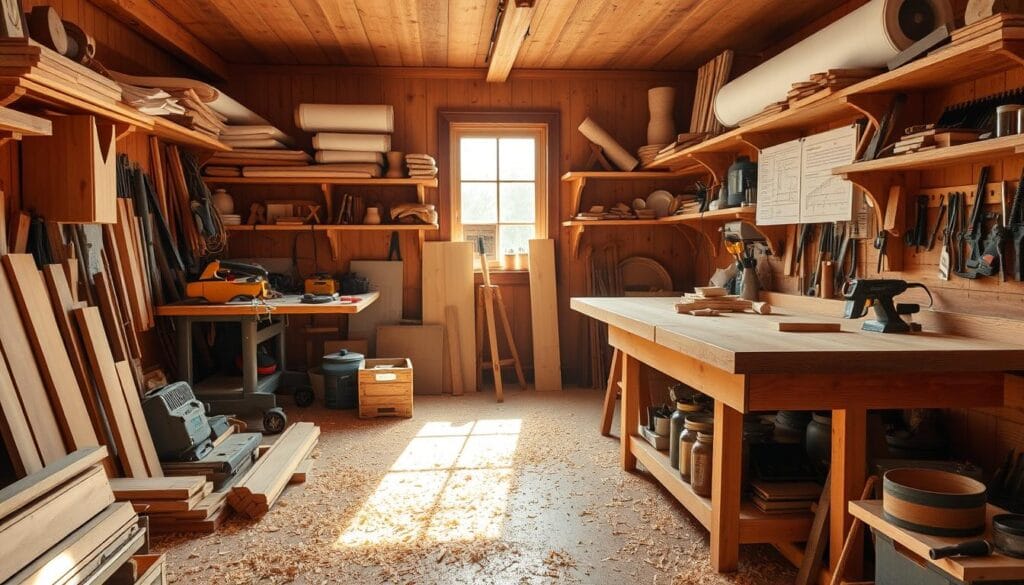
Joining Woodworking Communities After Classes
After finishing your woodshop training or furniture making workshops, joining a woodworking community is a great idea. These groups let you share projects, ask questions, and keep your creativity alive.
Online Forums and Social Media Groups
Places like LumberJocks and WoodworkingTalk are online spaces for woodworkers to connect. They can show off their work and get advice. Facebook groups for woodworking fans also offer lively talks and idea sharing.
Local Clubs and Associations
Local woodworking stores and community centers have clubs and associations. Woodcraft stores, for example, host CNC Users Group meetings every month. Members can share knowledge and learn about upcoming events and classes.
These groups, online or in-person, are great for getting project ideas, solving problems, and learning about new woodworking trends and techniques.
| Membership Cost | Orientation Class | Access Hours |
|---|---|---|
| $95 per month | $45 | 24/7 |
The Joinery is a local woodworking community with a well-equipped workshop. It costs more to join than traditional makerspaces. New members get a safety class and a five-week Intro to Woodworking class to start their journey.
Whether you’re experienced or new to woodworking, joining these communities can inspire you. It offers support and helps you improve your skills.

“Joining a woodworking community has been a game-changer for me. The support and shared knowledge have truly taken my skills to the next level.”
– Wendy Russell, Experienced Woodworker
Continuing Education in Woodworking
Woodworking enthusiasts looking to grow their skills have many options. Classes like “Woodworking Fundamentals II” at Woodcraft dive into advanced techniques and hands-on projects. Before starting, students need to take a basic woodworking class to build a strong foundation.
Workshops and Seminars
Woodworking workshops and seminars offer deep learning experiences. For example, a three-day “Build a Windsor Stool” class teaches traditional furniture making. These sessions cover a lot, from building fine furniture to wood finishing.
Online Learning Opportunities
Online platforms like Craftsy and Wood and Shop offer video courses for woodworking. These classes let you learn at your own speed, covering topics like cabinetry and wood carving. Many woodworking schools and groups also host online workshops, providing a wide range of learning options.
Investing in woodworking education is a smart move. It helps you improve your skills, try new things, and connect with the woodworking community. You can learn through classes, workshops, or online courses, all helping you grow your woodworking passion.
“Woodworking is not just a skill, it’s a lifelong journey of discovery and creativity.” – Master Craftsman, John Doe
Conclusion: Start Your Woodworking Journey Today
Starting your woodworking journey is an exciting step into a world of creativity and craftsmanship. Don’t be intimidated – everyone starts as a beginner! Classes like “Woodworking Fundamentals I” at Woodcraft are designed to welcome newcomers and build confidence. Remember, woodworking is a skill that improves with practice and patience. The satisfaction of creating something with your own hands is unparalleled.
Encouragement for Beginners
Whether you’re interested in furniture making, wood carving, or general DIY projects, there’s a class out there for you. Start by checking local offerings, be open to learning, and most importantly, have fun! Your woodworking adventure awaits, filled with the potential for lifelong learning and creative expression.
Final Thoughts on Learning Woodworking
Embracing the journey of learning woodworking, even as a beginner, can be a deeply rewarding experience. With the right resources, guidance, and a willingness to experiment, you can unlock a world of possibilities. Whether you’re seeking to develop new skills, express your creativity, or simply enjoy the satisfaction of crafting something with your own hands, woodworking classes are the perfect starting point. So, take that first step and embark on your woodworking journey today!
FAQ
What are woodworking classes?
Woodworking classes teach you how to work with wood. They start with the basics and go to advanced techniques. You’ll learn about tools, safety, and how to plan and make projects.
What are the benefits of taking a woodworking class?
Classes help you learn skills from experts. You get to use professional tools and make projects. They also let you be creative and meet others who love woodworking.
What types of woodworking classes are available?
Classes are for all skill levels. Beginners learn the basics, while more advanced classes teach complex skills. You can even learn special skills like knife making or wood carving.
What can I expect in a woodworking class?
Classes mix demonstrations with hands-on practice. You’ll use top tools like table saws and routers. Safety is key, and you’ll learn how to use tools safely. You’ll start with preparing materials and then move to assembling and finishing your project.
How can I find woodworking classes near me?
Look online by searching for “woodworking classes near me.” Woodcraft has a store locator. Also, check community colleges, adult education, and local woodworking shops for classes.
What are some popular woodworking techniques taught in classes?
Classes teach joinery, like mortise and tenon, dovetails, and pocket holes. You’ll also learn about finishing, woodturning, and carving. Advanced classes might cover CNC machines or furniture making.
What are the benefits of taking woodworking classes?
Classes boost your skills and confidence. They encourage creativity and offer chances to meet others. They’re a great way to start woodworking as a hobby or career.
What should I consider when choosing a woodworking class?
Think about class size, instructor experience, and cost. Choose a class that fits your skill level and schedule. This ensures you have a good learning experience.
What tools are typically used in woodworking classes?
Beginners use basic tools like table saws and routers. Advanced classes might introduce specialized tools, like lathes or CNC machines. Most classes provide tools, and you’ll learn how to take care of them.
What are the learning outcomes from woodworking classes?
You’ll learn to complete projects, improve hand-eye coordination, and understand wood better. These skills build confidence and prepare you for more complex projects.
Is certification important in woodworking?
Certification is not always needed for hobbyists. But, it’s valuable for professionals. Programs like the Woodwork Career Alliance of North America (WCA) and the National Wood Flooring Association (NWFA) show your skill level.
How can I continue learning and stay involved in the woodworking community after taking classes?
Join online forums, social media groups, and local clubs. These communities share projects, answer questions, and keep you updated on events and learning opportunities.
What options are available for continuing education in woodworking?
You can take advanced courses, workshops, and seminars. Online platforms also offer learning opportunities. These help you expand your skills and explore new techniques.
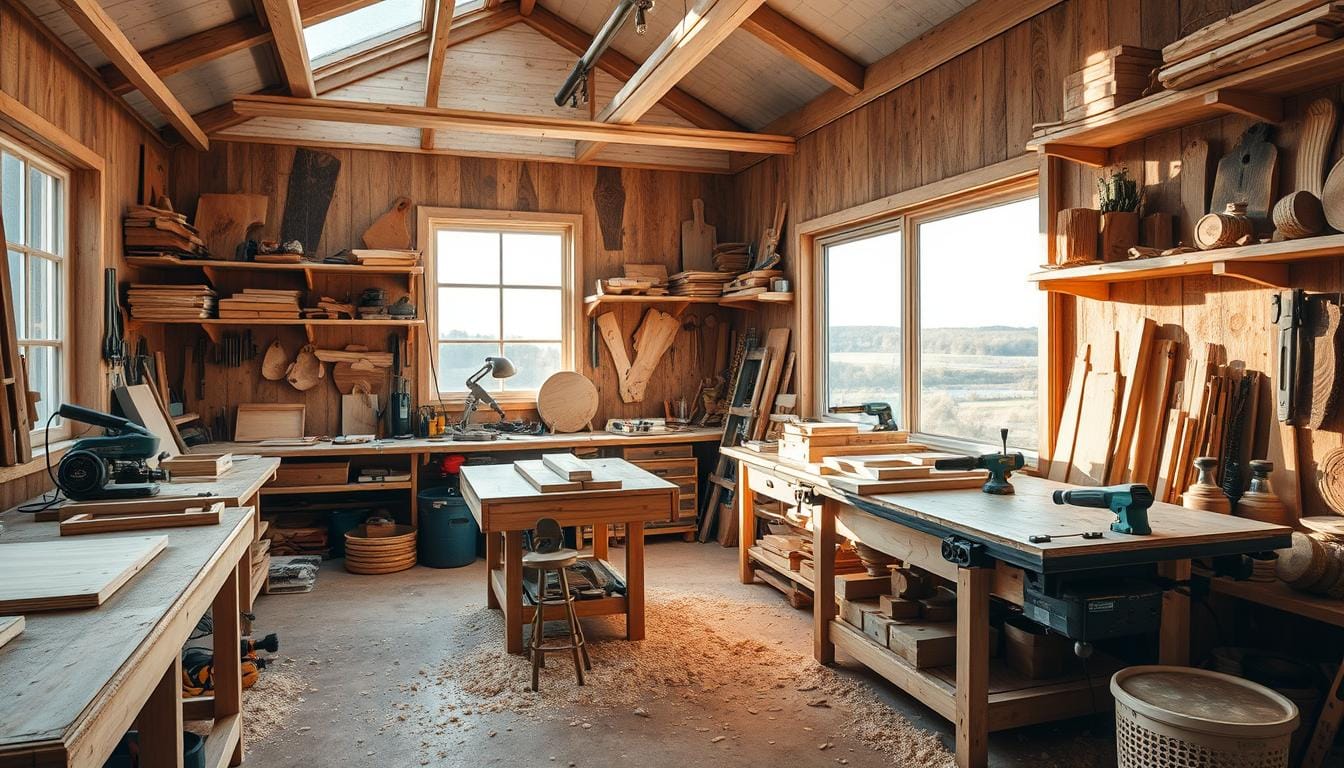
Have you ever thought about including a little bit more than just
your articles? I mean, what you say is important and everything.
Nevertheless imagine if you added some great graphics or videos to give your posts more, “pop”!
Your content is excellent but with pics and clips, this blog
could undeniably be one of the greatest in its field.
Excellent blog!